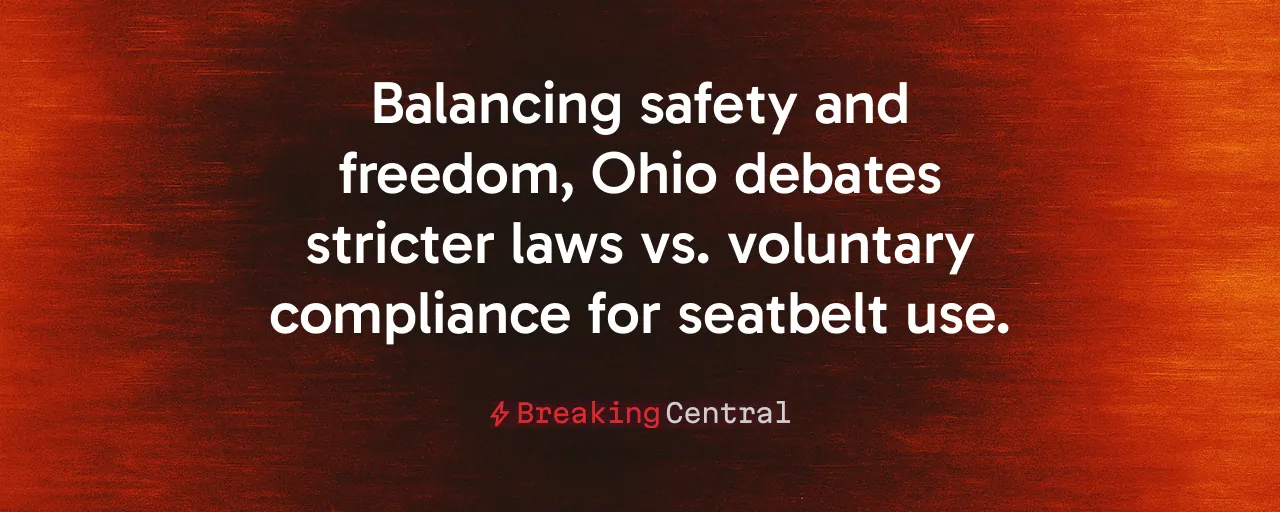A Campaign Born From Tragedy
Ohio's roads tell a grim story. In 2024, over 60% of traffic fatalities involved unbuckled passengers, a trend unbroken for five years. Governor Mike DeWine's 'Hard Hitter' campaign, launched in July 2025, aims to change that.
Using football imagery, it compares an unbelted passenger in a 50-mph crash to a 240-pound linebacker hitting with eight times the force. The message is clear: buckling up protects everyone in the vehicle.
The campaign arrives amid growing frustration. Ohio's seatbelt compliance rate, at 85.2% last year, lags behind the national average of 91.2%. DeWine, alongside Lt. Governor Jim Tressel and Public Safety Director Andy Wilson, is doubling down on awareness. But the push raises a deeper question: how far should the state go to enforce safety?
Personal responsibility lies at the heart of the issue. Every driver and passenger makes a choice to buckle up or not. The consequences, however, ripple beyond the individual, affecting families, friends, and even strangers sharing the road. This tension between freedom and safety drives the debate.
The Case for Choice
For many Ohioans, the decision to wear a seatbelt is a personal one. Data shows seatbelts cut fatal injury risk by about 45% for front-seat occupants, yet some still opt out. Why? For some, it's a matter of comfort or habit. For others, it's a stand against perceived government intrusion. The idea of expanding police powers to stop drivers solely for seatbelt violations, as proposed in House Bill 536, sparks unease.
Vehicle technology already nudges drivers toward compliance. Modern cars come equipped with persistent seatbelt alerts, and some models include interlocks that prevent the engine from starting without buckled belts. These market-driven solutions align with a preference for voluntary action over state mandates. Insurance companies could offer discounts for consistent belt use, rewarding responsibility without heavy-handed laws.
Historical trends support this approach. States like New Hampshire, with secondary enforcement laws, have seen steady declines in fatalities as vehicle safety features improve. Education campaigns, like 'Hard Hitter' or the 'Buckle Up with Brutus' program reaching 6,500 students, can shift behavior without new regulations. The question remains: is awareness enough?
Risks of Expanded Enforcement
Proposals to make seatbelt violations a primary offense, allowing police to stop drivers solely for not buckling up, raise red flags. Critics argue this opens the door to overreach, potentially leading to more traffic stops that disproportionately affect low-income or minority drivers. Ohio's secondary enforcement law, in place since 1986, requires officers to have another reason, like speeding, before citing a seatbelt violation. Changing this could strain trust between communities and law enforcement.
Economic concerns also loom. Fines for seatbelt violations could become a revenue stream for the state, placing an unfair burden on citizens already struggling financially. The Ohio General Assembly, led by Republican lawmakers, has resisted primary enforcement laws in 2009, 2010, 2017, and 2024, citing these risks. Each rejection reflects a broader skepticism of regulations that chip away at individual freedom.
Then there's the practical side. Training officers to enforce new rules fairly would require time and resources. Public backlash could follow if stops are perceived as pretextual. With compliance already rising from 80.8% in 2022 to 85.2% in 2024, some argue the current system, paired with campaigns, is working well enough.
Balancing Lives and Liberty
The stakes are high. Reaching a 92% compliance rate could save Ohio $91 million in Medicaid costs over a decade, alongside countless lives. Rural and young male drivers, who show the lowest compliance, stand to benefit most. However, the push for safety requires respect for personal choice. Ohio's Safety Belt Task Force, formed in 2023, found that rear-seat passengers and local trips see the least belt use.
Targeting these areas with education could close the gap. Compromise offers a way forward. A 'primary-plus-diversion' model, where first-time offenders take a free safety course instead of paying fines, could encourage compliance without punishing drivers. Transparent reporting of stop data would address equity concerns. Automakers could also play a role, deploying advanced seatbelt sensors or alerts to make buckling up second nature.
Ohio's history shows progress. Compliance peaked at 85% in 2014 before dipping to 80.8% in 2022, prompting renewed action. Neighboring states with primary laws, like Michigan and Kentucky, boast higher usage rates, but Ohio's approach, rooted in voluntary action, reflects a different priority: preserving freedom while promoting safety.
A Call to Action
Ohio's 'Hard Hitter' campaign is a bold step, but its success hinges on citizens. Drivers and passengers hold the power to protect themselves and others with a simple click. The state can amplify this message through schools, media, and community partnerships, as seen with the 'Buckle Up with Brutus' program. These efforts respect individual choice while addressing a public health challenge.
Lawmakers face a tough decision. Strengthening enforcement could save lives but risks eroding trust. Instead, doubling down on incentives, like tax breaks for consistent belt use or partnerships with automakers, keeps the focus on responsibility. Ohioans value their independence, and policies reflect that.
Every trip offers a chance to make the right call. Buckling up is a choice that values life, both your own and those around you. As Ohio navigates this debate, the road ahead demands clarity, respect for choice, and a commitment to safety that unites rather than divides.
